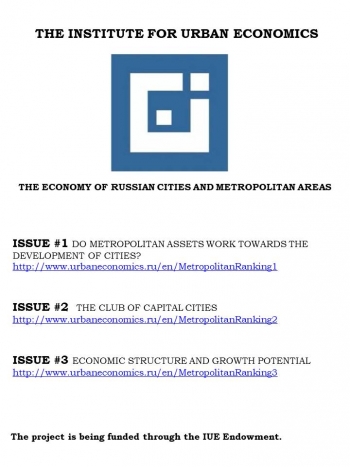Almost throughout the last 25 years, there have been expert discussions regarding structural changes needed by the Russian economy to switch to a new model of economic growth – growth driven by innovations rather than the production and sale of resources.
In recent years, the most active discussion has had to do with the key role of cities and metropolitan areas - as territories currently accommodating 70% of Russia’s population - in the transition to a new economic growth model. This process is heavily dependent on major cities and metropolitan areas as centers of human capital development providing the best opportunities for education, scientific activities, cultural development, and entrepreneurship.
In our opinion, a serious discussion of the role of major cities and metropolitan areas in the country’s further socioeconomic development requires a thorough analysis of past and current processes in their economies. The following key questions need to be answered:
- What kind of economic structure is specific of major cities and metropolitan areas and whether it is consistent with the modern trends of economic growth?
- Can any positive structural changes be seen in the economies of individual major cities and metropolitan areas despite their lack in the economy of the country as a whole? If yes, where exactly?
- What government support measures are needed for different types of major cities and metropolitan areas based on their current and prospective role in supporting Russia’s economic growth?
In 2016, the Institute for Urban Economics developed a unique methodology for measuring the gross urban product (GUP) of cities and metropolitan areas, which was used to calculate GUP values for the period from 2000 to 2015 for twenty major metropolitan areas with populations exceeding 1 million, to evaluate the contribution of these areas to the Russian GDP, and to draw international comparisons.
In 2018, taking into account the expanded statistical data in the Rosstat (Federal State Statistics Service) Municipal Entity Database (MEDB) and Rosstat’s cessation of data updates with a breakdown by urban settlement, the Institute for Urban Economics updated the GUP measurement methodology.
This update was based on a transition from using data by city (urban settlement) to using data by municipal entity. Additionally, the number of metropolitan areas was substantially expanded, to 45 major metropolitan areas with populations exceeding 300,000.
The most important analytical achievement in 2018 was the extensive measurements of the economic structure of 45 metropolitan areas across the full range of industries [3] based on which the sectoral structure of Russia’s GDP is measured. This suggested conclusions regarding the qualitative processes happening in the economies of metropolitan areas, whether they differ from the processes across the country, and, most importantly, whether any structural shifts are happening in the economies of metropolitan areas allowing us to improve their competitive strength globally, accelerate economic development in their territories, and increase their contribution to the Russian GDP.
The main conclusions of the study are as follows:
1) Out of the 45 metropolitan areas reviewed, 11 areas (5 macroregional centers and 6 metropolitan areas of regional significance) are even now characterized by a developed modern economy and a high potential for further natural structural shifts. These areas have created the necessary framework for socioeconomic development, while the best type of government support for such areas includes financial support for infrastructural projects in their territories and raising the level of independence of municipal administration, to help enhance the role of such areas in Russia’s economic growth..
2) Eight other metropolitan areas are of importance for the country’s economic development, as they support the current resource-based macroeconomic development model. The diversification of the economies of these metropolitan areas is a difficult and as yet impractical task, whereas government support is advisable for maintaining the necessary level of their social development.
3) The largest group (21 metropolitan areas) consists of areas with industrial economies and a moderate potential for structural shifts. Their development model is based on a single specific manufacturing sector (and supporting industries) or on government expenditures. Due to Russia’s poor competitive performance in manufacturing, the role of these areas in GDP growth is low, though important for diversifying the economy. The economies of these areas primarily require direct support for restructuring, i.e. a set of both financial and non-financial measures of such restructuring.
4) Five metropolitan areas have no role in the country’s economic growth today; their economic model is focused on satisfying the most basic local needs of their populations and demonstrates little growth prospects due to the gap between the private and the public sector (extremely high share of undisclosed incomes). A priority for the government policy in respect of these areas is a dramatic reduction of the share of shadow economy in their territories.
The series of publications of the basic indicators of economic development of Russian cities and metropolitan areas, “The Economy of Russian Cities and Metropolitan Areas”, was launched by the Institute for Urban Economics in 2017. The project is funded from the special-purpose capital of the Institute for Urban Economics. This issue uses some of the calculations made in 2018 at the order of the Center for Strategic studies.
The second issue Economies of Russia’s cities and metropolitan areas. Issue #2: The club of capital cities
The first issue IUE Metropolitan ranking: Do metropolitan assets work towards the development of cities?




